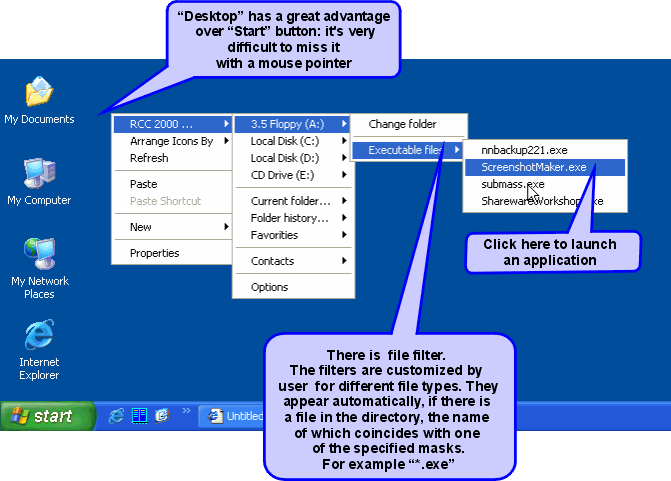2. Brief instruction in pictures.
*Note: if you purchase RCC, you will get free updates and support during one year
All users who want to save their time and make computer work more comfortable will find the Right Click Commander program (RCC) very useful as a convenient enhancement of Windows Explorer.
This newcomer from the Linux world is organically and logically developing a fine idea of KDE authors, it is a simple and powerful means of managing files and directories. Using Explorer window and multi-level menu, in which files and directories are represented as items and sub-items, RCC breaks the settled stereotype of how a typical file manager should look. Thanks to abandonment of notorious two panels of “Norton commander” and its clones, the core essence of RCC is revealed – the way in which a user performs in it usual file operations. Change of a current folder (or opening of a new one) now can be achieved by just single click of the mouse, moreover, this opportunity exists in the windows “Open” and “Save As’ of any application! Using customizable file filters one can similarly open a file or launch a program. Those who often send files by e-mail will undoubtedly appreciate the ability of RCC to send highlighted files to any addressee from Windows Address Book.
Can you imagine a file manager that doesn’t perform “Copy” and “Move” operations? This functionality is maintained in the house style of RCC and is intuitively understandable for even inexperienced users.
As one of the pleasant and useful bonuses, which are usually offered as separate products, RCC provides access to the list of last directories in use and a set of user-editable “Favorites”.
Thanks to the integration with «Explorer» RCC don’t overload “Tray” area with its icons and doesn’t register itself in “Start Up”, which is also essential.
2. Brief instruction in pictures.
To call RCC click the right button of the mouse on “Start” (Pic. 1) or “Desktop” (Pic. 2).
(Pic. 1)

Pic. 2. This way you can run any program or open existing document.
User can customize file filters with “File filters editor” tab in “Options” dialog box.
Pic. 3. Calling the properties window.

Pic. 4. Working with the "Filters editor" tab.

Pic. 5. working with the "Options" tab.
The next picture presents some more unique features of The RCC.

Pic. 6. RCC works in standard dialog boxes!
Can you imagine a file manager that doesn’t perform “Copy” and “Move” operations? This functionality is maintained in the house style of RCC and is intuitively understandable for even inexperienced users.

Pic. 7. "Copy" ("Move") operation.

Pic. 8. Sending E-mail.

Pic. 9. Opening standard "Run..." dialog.

Pic. 10. Running program with command-line parameters.

Pic. 11. Using RCC with Total Commander.
| Supported OS’es: | MS Windows 98/Me/2000/Xp |
| IE: | 4.0 or greater |
Simply launch RCCSetup.exe and follow directions.
(C) Rocata Software, 2002-2003
e-mail: allo@leasat.net

